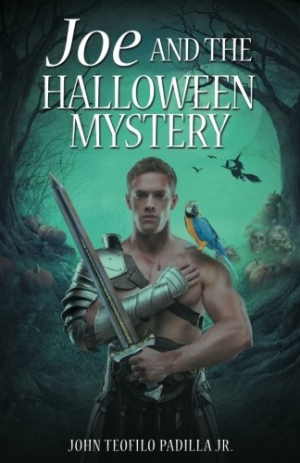
Joe and the Halloween Mystery
The allegorical narrative revolves around a battle with Satan, drawing clear, black-and-white lines.
This follow-up to Joe and the Peace Eternal is a swashbuckling biblical fantasy that pits a hunky former Olympian and his trusty, wisecracking parrot against the worldwide forces of evil on Halloween night and the Day of the Dead.
On Halloween, Joe Benson wakes from a nightmare involving a losing battle with Satan. Joe Benson is no ordinary man; he is a former Olympic fencer turned gladiator, samurai, and royal knight in present-day Beverly Hills tasked by God to fight the forces of evil. A shaken Joe prays to God for guidance and divine inspiration in his battle with Satan’s minions later that night.
While Joe is visiting his parents’ and grandparents’ grave sites, God resurrects Joe’s deceased parrot, Herbie, to help with his mission. Together, Joe and Herbie battle pig-faced demons, vampires, witches, evil abbesses, and the serpentine Molech on the streets of Beverly Hills, in the rain forests of Mexico, and in the majestic halls of the Vatican, culminating in a final stand on a mysterious island that will determine the fates of all.
The narrative structure flows as a result of a clean and simple writing style. The writing has a clear and strongly Christian bent, drawing obvious black-and-whites lines between good and evil. Despite implications, there is little mystery here; the narrative revolves around Joe’s battle against Satan, and all of the story’s elements go toward furthering his goals.
Despite the clear plot direction, the natures and roles of minor characters are confusing. Joe and Herbie are the obvious protagonists, and all descriptions related to their appearances and behavior—including the well-muscled, mild-mannered, chaste hero and religious servant Joe thinking and speaking in terms of chivalry and biblical verse—reinforce this point. However, the book takes a kitchen-sink approach to its minor characters, throwing them into chapters with no obvious connections to the rest of the story. Their roles are not well defined, and their natures, especially for “good” characters, are often ambiguous and at odds with the direction of the plot.
This confusion extends to the story’s timelines. Jarring transitions exist within paragraphs; characters who seem involved in the action are revealed to be doing something else entirely in the very next sentence. The story is heavy on exposition and light on dialogue, and scenes become muddied as a result. Logical inferences must be made to fill in the blanks. What might seem obvious or important in one chapter becomes abandoned in the very next.
Joe and the Halloween Mystery is a spiritual fantasy that doubles as a religious allegory about good versus evil.
Reviewed by
Nancy Powell
Disclosure: This article is not an endorsement, but a review. The publisher of this book provided free copies of the book and paid a small fee to have their book reviewed by a professional reviewer. Foreword Reviews and Clarion Reviews make no guarantee that the publisher will receive a positive review. Foreword Magazine, Inc. is disclosing this in accordance with the Federal Trade Commission’s 16 CFR, Part 255.
